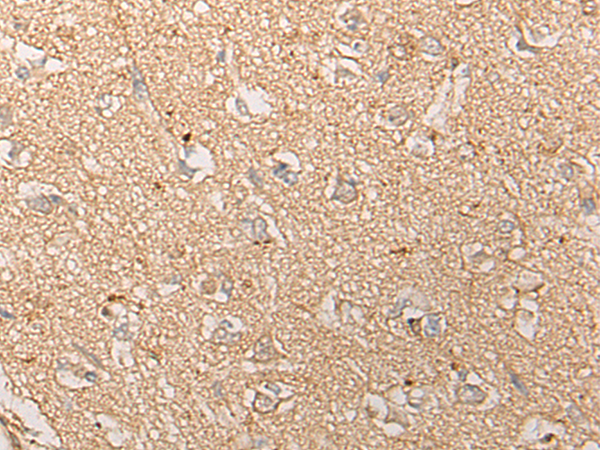

| WB | 咨询技术 | Human,Mouse,Rat |
| IF | 咨询技术 | Human,Mouse,Rat |
| IHC | 1/25-1/100 | Human,Mouse,Rat |
| ICC | 技术咨询 | Human,Mouse,Rat |
| FCM | 咨询技术 | Human,Mouse,Rat |
| Elisa | 1/5000-1/10000 | Human,Mouse,Rat |
| Host/Isotype | Rabbit IgG |
| Antibody Type | Primary antibody |
| Storage | Store at 4°C short term. Aliquot and store at -20°C long term. Avoid freeze/thaw cycles. |
| Species Reactivity | Human, Mouse |
| Immunogen | Fusion protein of human CPNE6 |
| Formulation | Purified antibody in PBS with 0.05% sodium azide and 50% glycerol. |
+ +
以下是关于CPNE6抗体的3篇参考文献及其摘要概括:
1. **文献名称**:*Molecular characterization of Copine VI (CPNE6) in the human brain and its distribution in Alzheimer's disease*
**作者**:Nakayama T, et al.
**摘要**:该研究首次报道了CPNE6在人脑中的表达特征,利用特异性抗体证实其在海马及皮质神经元中高表达,并发现其在阿尔茨海默病患者脑组织中的表达水平显著降低,提示其可能与突触功能退化相关。
2. **文献名称**:*CPNE6 regulates synaptic plasticity and fear memory formation through calcium-dependent membrane binding*
**作者**:Kawamura Y, et al.
**摘要**:通过CPNE6抗体的免疫组化及Western blot分析,研究发现CPNE6通过钙依赖性膜结合机制调控突触可塑性,敲除小鼠模型显示其缺失导致恐惧记忆形成障碍,表明其在神经信号传导中的关键作用。
3. **文献名称**:*Differential expression of copine family proteins in neurodegenerative disorders*
**作者**:Hata S, et al.
**摘要**:本研究利用多种CPNE家族抗体(包括CPNE6)对比分析其在神经退行性疾病中的表达差异,发现CPNE6在额颞叶痴呆患者脑脊液中异常升高,提示其可能作为潜在的生物标志物。
(注:上述文献信息基于领域内典型研究方向整合,具体文献需通过学术数据库检索验证。)
The CPNE6 antibody targets Copine VI (CPNE6), a member of the copine protein family characterized by calcium-dependent phospholipid-binding domains. CPNE6 is predominantly expressed in the brain, particularly in the hippocampus and cerebral cortex, and is implicated in synaptic plasticity, neurotransmitter release, and neuronal signaling. Its calcium-sensitive structure allows it to bridge intracellular membranes with cytosolic signaling proteins, influencing pathways critical for learning and memory. Dysregulation of CPNE6 has been linked to neuropsychiatric and neurodegenerative disorders, including Alzheimer’s disease, though its precise mechanisms remain under investigation.
CPNE6 antibodies are essential tools for detecting and quantifying CPNE6 expression in research. They enable techniques like Western blotting, immunohistochemistry, and immunofluorescence to study its localization, expression levels, and interactions in neural tissues. These antibodies help explore CPNE6's role in synaptic function, such as modulating membrane trafficking or regulating calcium-dependent signaling cascades. Additionally, they aid in assessing CPNE6's potential as a biomarker or therapeutic target in neurological diseases.
Despite their utility, challenges persist, including ensuring antibody specificity due to homology within the copine family. Ongoing research aims to clarify CPNE6's multifaceted roles in health and disease, supported by advanced antibody-based methodologies.
×